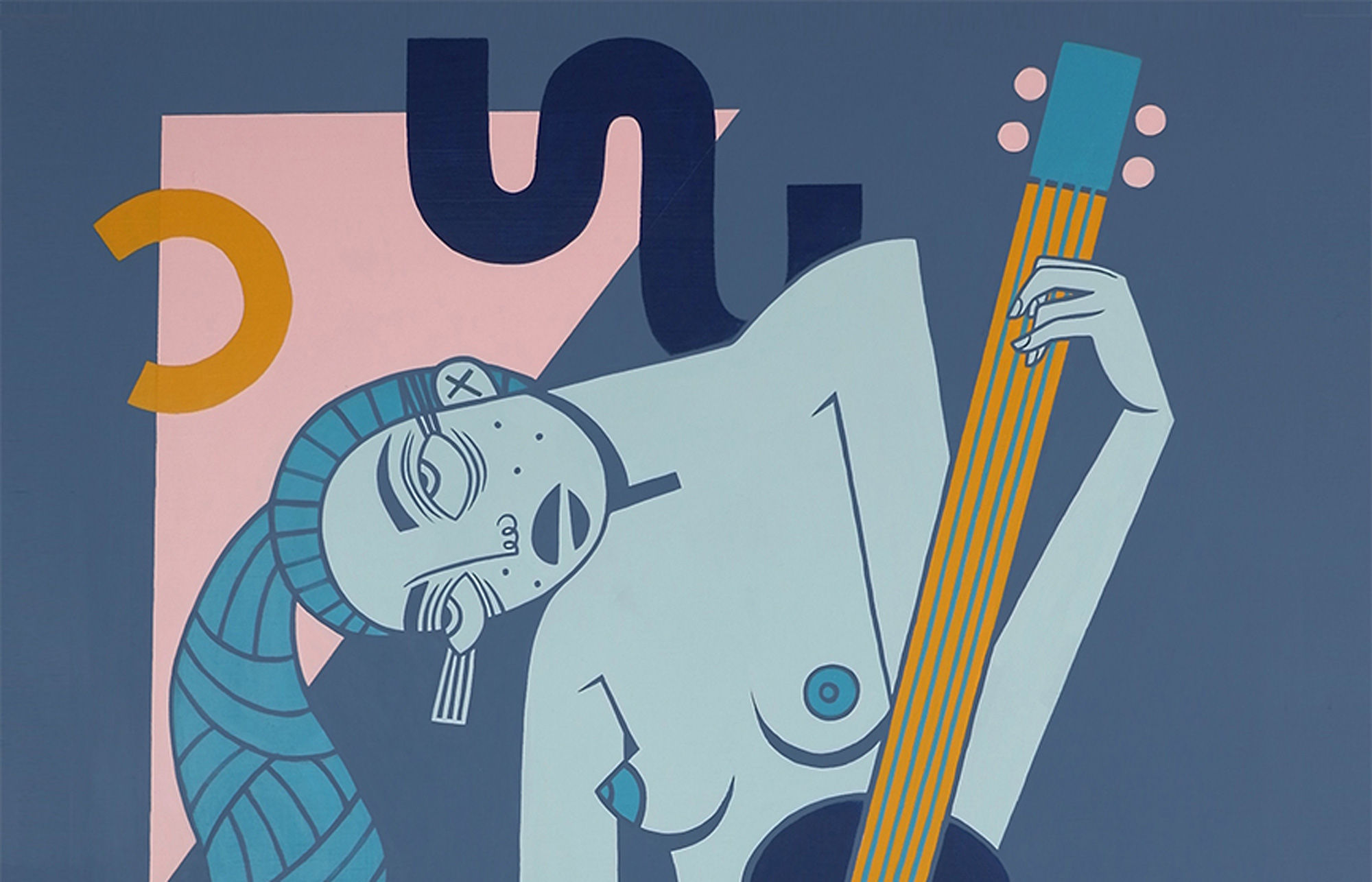
Jillian Evelyn
Beyond Breaking The Mold
Interview by Eben Benson // Portrait by David Broach
Monumental shifts are constantly underway, and at any given moment, we’re part of intersectional and structural changes that happen without our conscious consent. Three years ago, Jillian Evelyn was living in Boston working for footwear giant Converse, choosing aesthetics and designs for their wide array of shoes. By the end of 2017, Jillian had moved to Los Angeles, having just sold out her show at the Juxtapoz Clubhouse in Miami, a number of solo shows under her belt, and a mounting buzz humming behind her rapidly growing career.
It’s possible that Jillian had it all planned out, that she knew she would thrive upon leaving. However, it takes a lot of faith and honesty to move away from the safe path and bare your face to the harsh wind of criticism that comes with making and selling art. But still, three years in, here she is.
When I interviewed Jillian for our website last September, we spoke about the contorted figures in her work, their discomfort, her shift from acrylic to house paint, and how color choices come from the gut. Looking back, that statement about color provides insight into how she chose to leave a stable design job for a solo career. In the same instinctual way she envisions her unique selection of colors and surfaces, she banked on that intuition to emerge from the flock in middle America to become one of the freshest painters in the LA art scene.
Eben Benson: Since our last interview, a lot has changed. You’ve been in a number of exhibitions, you showed work in our Juxtapoz Clubhouse, and you’ve got more on the horizon. You’re hustling. Tell us what your day-to-day has been like, trying to keep up with all the changes, and tell us about some of the projects you’ve been working on.
Jillian Evelyn: Honestly, its been bananas, and I think I may be a little bit in shock. I have shows lined up with my favorite galleries up to 2020, and here I am being featured in a magazine that I’ve admired for more than a decade. All of my dreams are coming true all at once, and it’s slightly terrifying, but I’m doing my best to not to think about it too much. Each morning, I wake up, drink some coffee, and make a list of what I need to accomplish for that day. If I focus too far out, my anxiety becomes paralyzing, so it’s really about focusing on one painting at a time, and how I can make that one better than the last.
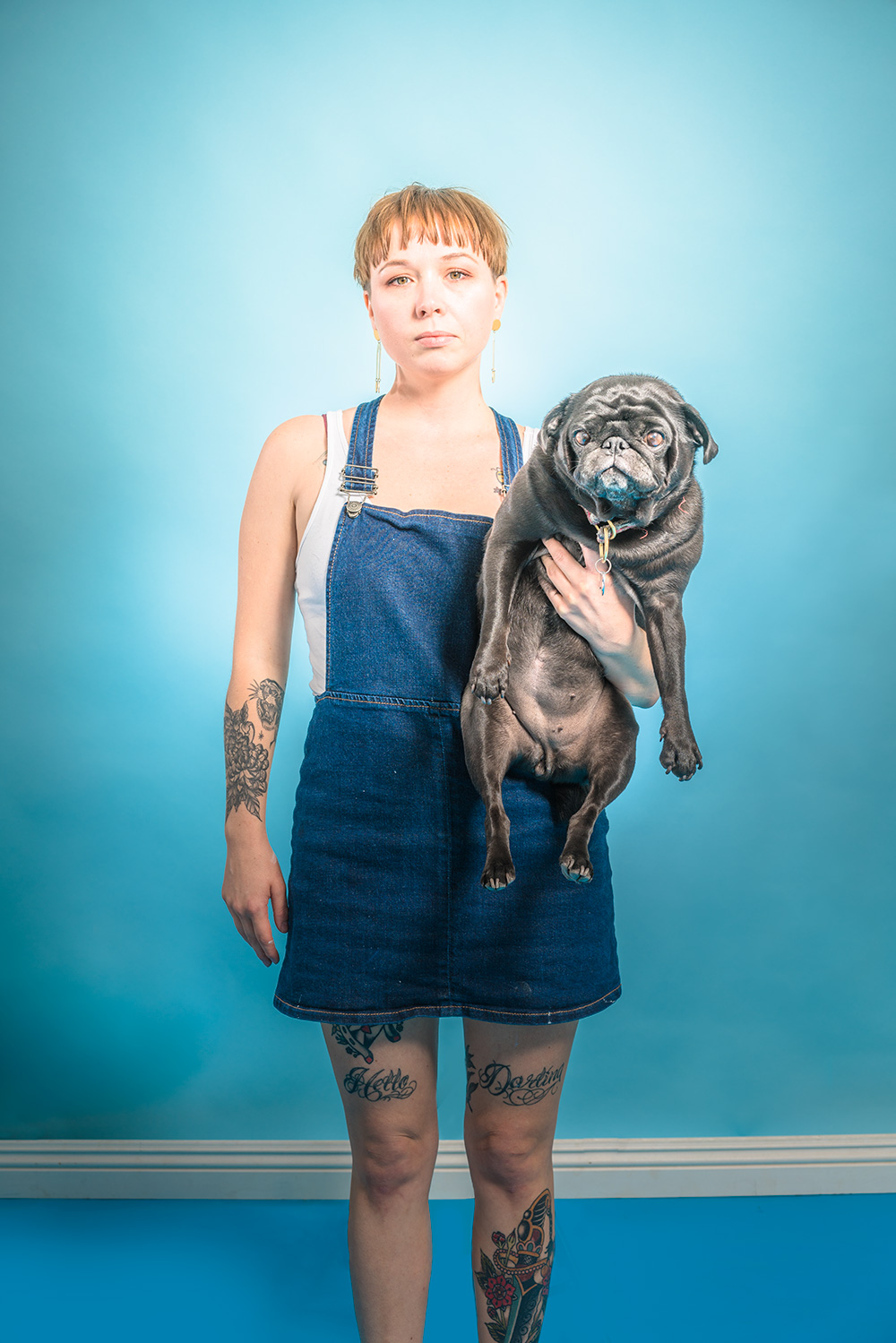
When did you start drawing?
I’ve been drawing as far back as I remember. My mom has this story about when I was three or four and started drawing a vase with flowers, and the way I approached it, she had no idea what I was drawing until I was totally finished. She says that I had a way of seeing things that was different. It wasn’t the way most kids would draw something. I surprised her as a kid, and she recognized that I had a unique way of seeing things, and she’s always been very supportive.

With a background in footwear design, what aspects of working in commercial design jobs have spilled over into your current work as a full-time artist?
At the time, I don’t think I knew how impactful my career in footwear would be on me or my art. Working for brands like Converse and TOMS, I learned a lot about the DNA that makes a brand, how to merchandise a product line, and the importance of storytelling. The experience gave me a good foundation, but I always felt a bit out of place because the work didn’t feel like a full expression of me. The experience of being unable to fit into a mold and feeling a bit like a fraud ultimately broke me. As I decided to work on my art full time, I took what I had learned and used these feelings to drive my expression. You can only try to fit into a mold for so long.
How do you feel that branding, especially personal branding, plays a role in being an artist today? The concept is often met with a lot of suspicion, but it’s nearly impossible to avoid.
It’s probably impossible to avoid because it often just happens naturally. One of the things that characterizes an artist is that they go after a style that feels unique to them, and that specific style can come to be defined as a brand. It’s been happening forever, but now we just have an established term that’s associated with the world of advertising. The tricky thing is being conscious about how you’re being positioned without thinking too much about what other people think. You have to work hard to stay in touch with yourself and not let others intrude on that process.
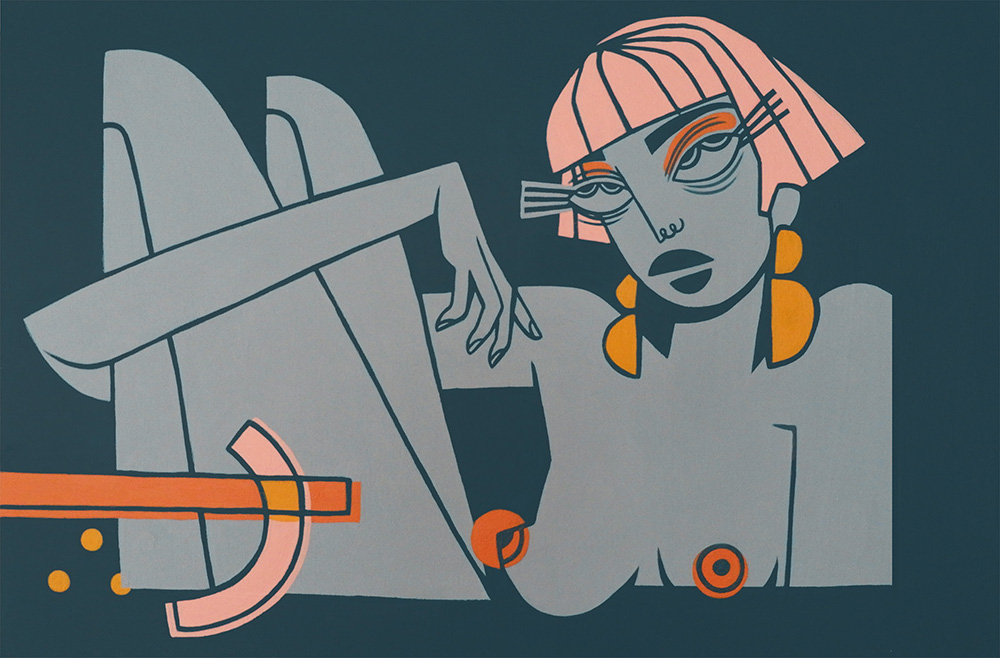
In what ways do you feel that your femininity is expressed in these paintings, and how much do you feel like you're exploring femininity in general?
I am a female artist and, like any artist, I’m exploring my personal experiences, so it’s just natural that my work would explore femininity. I grew up with three older brothers in the boonies of Michigan, and my mom always used to try to get me to dress up, grow my hair long, and be more feminine. I was really aware of the classic concept of femininity and I knew it wasn’t me. I’ve been cutting my hair off since I was five years old, and I’ve been navigating this world of what I’ve been told being feminine is versus what being a woman means to me.
In my work, I break down the body into shapes—a mix of curves and sharp edges to create an image of what being a woman feels like for me. We aren’t all soft around the edges and the body doesn’t have to represent something sexual. We have these limbs to hold us up and keep us in place. But that’s just my work now, and I know my feelings towards myself will evolve. I’ve been talking to my partner about having kids one day, and I know that experience will bring a whole other view of what it feels like to be a woman. I’m really looking forward to my personal growth and how it will continue to affect my work.
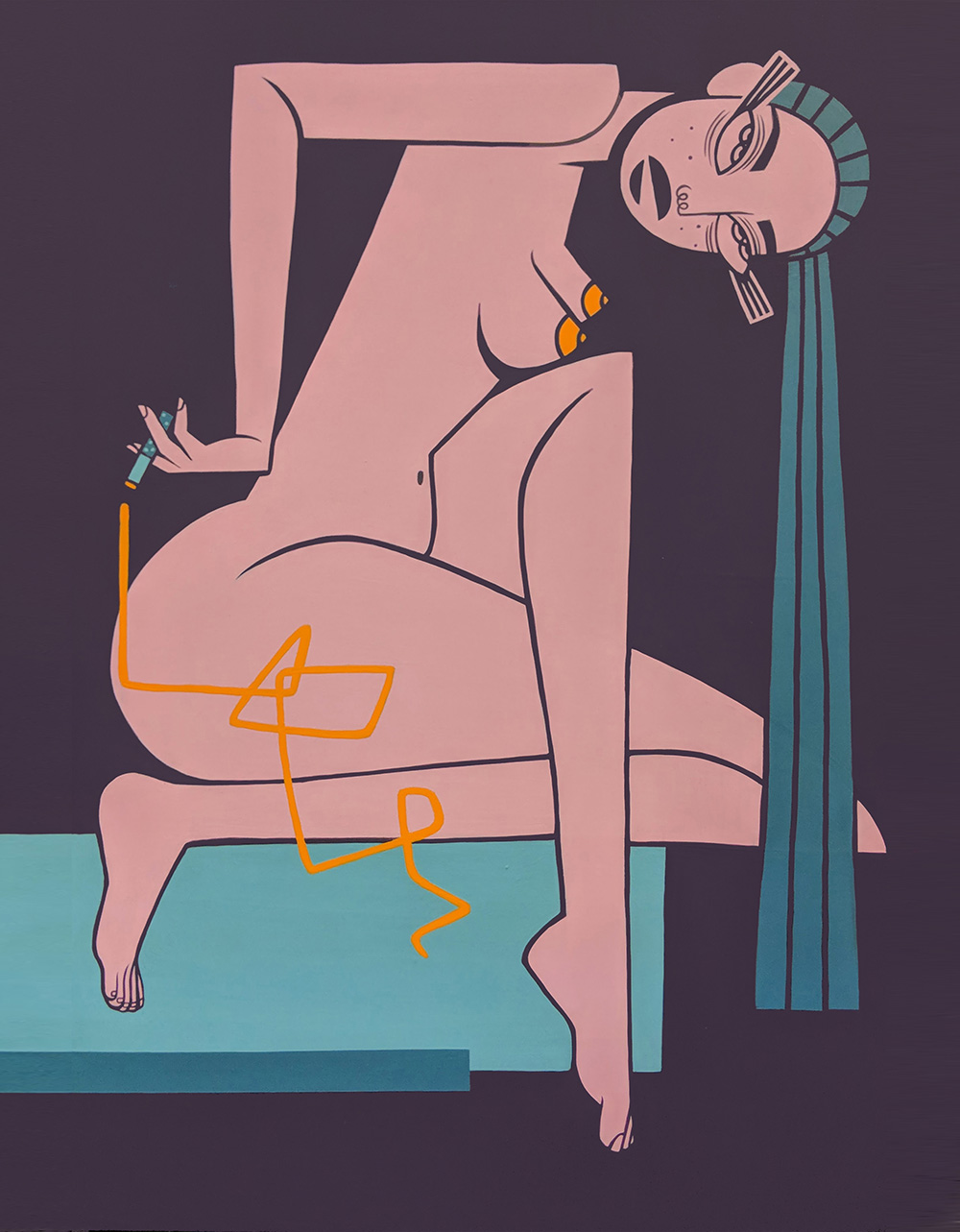
I feel like it's not mentioned enough that you're adept at painting on a wide array of surfaces and structures. What are some things you love about painting on materials other than canvas?
A lot of my work is about one’s connection to their physical and mental state, so I love to be able to explore different surfaces that help exaggerate those feelings. I also started painting on other objects as a way of repurposing them. Since I come from a product background, I am aware of how much waste comes from mass production. It’s my way of giving a new purpose to something that may have ended up in a landfill.
Many of the women you paint smoke, although you don’t. What’s the idea behind the cigarettes?
I’ll have a cigarette every so often. Growing up, my mom smoked, so I’ve been close to it for a good chunk of my life. For me, smoking is a way to represent fear and anxiety, or trying to calm fear and anxiety.
Do you feel you were raised in a traditional atmosphere? Would you say your life has diverged from the path that you or your family expected?
I grew up in a very blue-collar household in Michigan. My entire extended family worked in the automotive factories, and my parents actually met at General Motors. Work ethic was very important in our house. My dad worked a lot and still does to this day. He currently builds houses, and I don’t think many people get to say that every house they grew up in was actually built by their dad. My mom is a kitchen designer at Home Depot, and it’s been pretty neat to watch my parents work together on designing a home. Two of my brothers followed a similar path as my dad, and are both tradesmen, and my other brother is a cop. Growing up, I definitely felt like the black sheep, but the more I step back and look at my art, I realize I’m not that different. I paint with house paint and I use wood as canvas. I enjoy picking up paint at the hardware store because it reminds me of visiting my mom at work or spending time with my dad on job sites growing up.
What are some things that you appreciate about coming from that background, and what were some challenges? Having grown up on a dairy farm, I always felt like the arts were this exclusive club that was off-limits to working-class kids like me.
I can only speak about my experience, but I learned a lot about perseverance through my parents’ work life. Some years, we would have money and things felt comfortable, and then others I’d wake up and our car was gone because it had been repossessed. The automotive industry paid well but there were so many layoffs while my parents were working. They never let it get them down, though. I’ve watched my parents lose their house and go through bankruptcy, but all they did was say, “Oh, well, at least no one died,” and found another way to pay the bills. So, yeah, my parents didn’t own art or take me to museums, but they taught me some lessons that, in the long run, feel more important. I learned that you can accomplish a lot and overcome a lot as long as you persevere.
In going to art school, is there something you wish you would have learned during that time that you didn’t?
I had a good experience in school, but one thing I wish I would’ve learned is that finding your own style is so much about finding yourself. In school, and for much of my career, I spent so much time trying to figure out how I fit in to what was established, and I didn’t realize that there could be this other path. I eventually learned to stop avoiding who I really am and embrace it instead. That’s a lot of what my art is about—trying to fit a mold and the struggle to do so.

What drew you to California, and what are some of the benefits and detriments about moving to Los Angeles?
Los Angeles really inspires me. Even though I’ve lived here for a few years, I still get excited when I see a palm tree or the mountains as I drive along the highway. Plus, I’m surrounded by artists and creatives that I respect and who inspire me. Artists are naturally products of their environment. My upbringing in Michigan shaped me, and Los Angeles feels like a place where I can fully express myself now.
What are some things that you find exciting about being an artist today?
When I walk into a gallery, most people don’t assume I’m an artist—even when I’m standing in front of my own work. I’ve had people treat me like I’m a fan or someone who is working the event. It’s exciting for me to have the opportunity to flip these assumptions and gradually erode popular expectations for women, especially women in creative fields.
What is one movement in art today that gets you excited? Are there any particular groups of artists focusing on a concept that you think opens new doors and explores new ideas?
I’ve been seeing a lot of artists use 35mm film or disposable cameras to capture their lives. This excites me because there’s an intimacy to the images. There’s a certain detachment that comes with the images we see every day on our phones, and I look forward to more people exploring the feelings that exist in the honest moments of our lives.
In our Winter 2018 cover story, Kerry James Marshall said, "It's a complete miscomprehension to believe that you don't need to do the same things that Rembrandt was doing," in reference to traditional mastery of the craft of painting. How do you treat reverence for the style and technique of the classical Masters? And how much do you find yourself drawing from them? What is the dialogue between technical skill and concept for you, in both your own work and the work of others?
When I was working full-time, I only had nights and weekends to paint. It was easy for me to lose sight of the importance of preliminary sketches and planning. The Masters were meticulous and would create multiple studies to create the best piece, or to get the lighting just right. Whether you work full time or experience the pressure of needing to post consistently on social media, it’s easy to skip the most important steps. I fell victim to a lot of bad habits and I’m still working to go back to enjoying the process. Kerry James Marshall is certainly correct, and this year I’m looking forward to focusing more on the process.
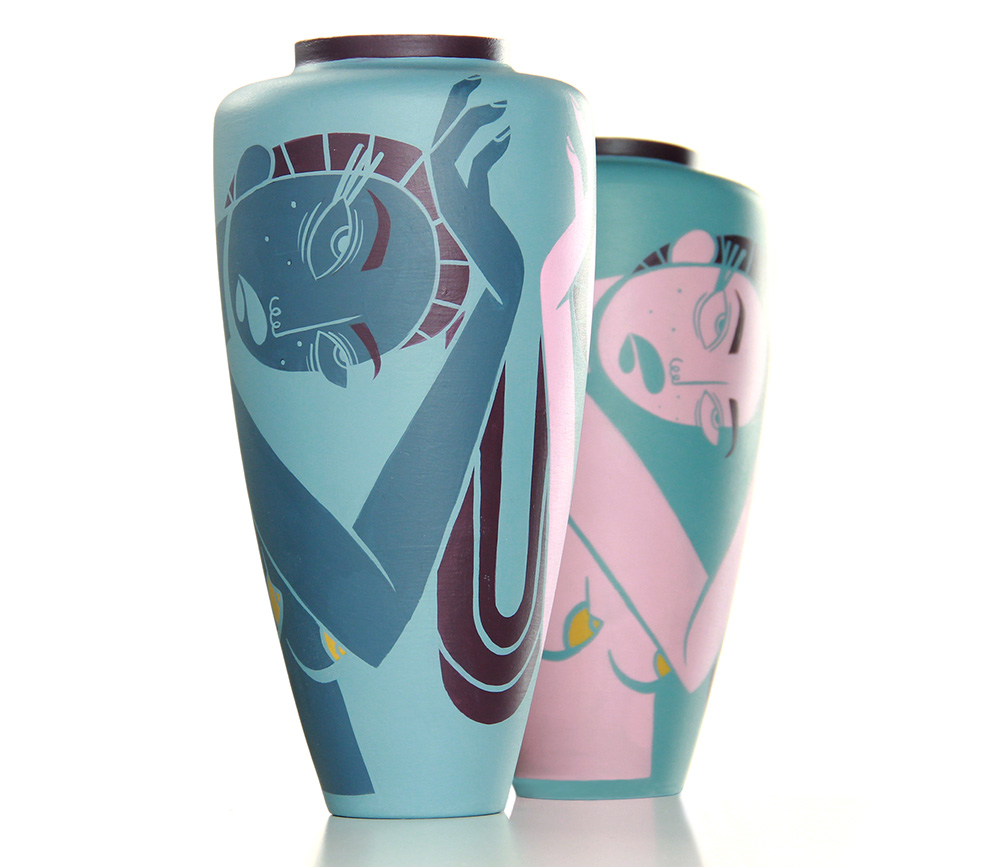
What are some activities or techniques you use to stay grounded?
Podcasts and audiobooks! I don’t have that much time to sit down and read anymore, so if I’m not painting, I want to spend my free time actually living my life. Audible has become a huge part of my routine. I also feel like a better version of myself if I always have a book in rotation.
Where to from here?
All over the place! I have a few group shows that I’ll be in this year, and a handful of solo shows in the works for the next couple of years. But I am also hoping to do a lot more beyond the gallery realm as well. I would like to collaborate with local furniture makers, ceramicists, and maybe even some brands! I’d also like to create a line of items that are slightly more affordable but still locally made in limited runs.
Jillian Evelyn will have a solo show at Superchief NY, opening June 15, 2018.





